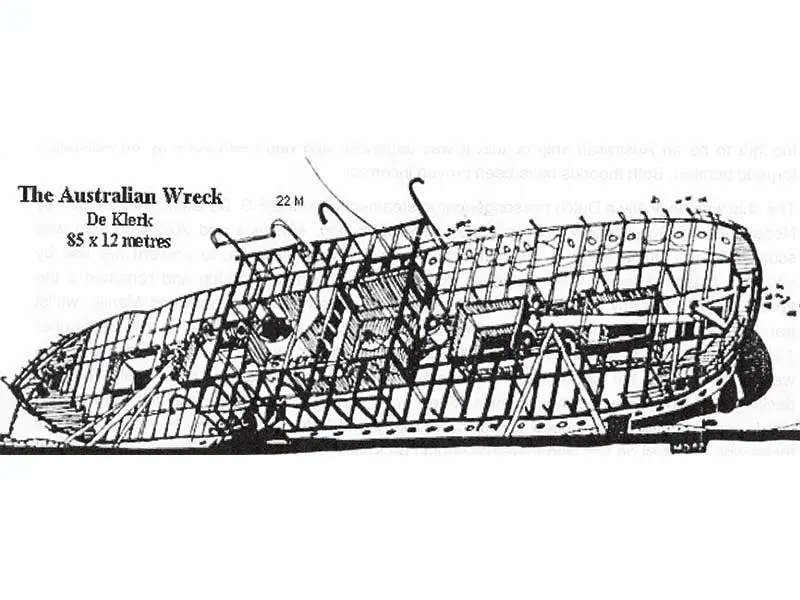Australian Wreck
AOwner: NV Koninklijke Paketvaart Mij (KPM) Batavia Built in 1900 by Nederlandsche SB, Amsterdam, Holland. Yard No: 33. Date of completion: December 1900. Gross Tons: 2035. Length: 91.4m Beam: 12.3m Type: Passenger/cargo powered by triple expansion steam engine. Speed: 12 Knots Fate: Struck a mine in Brunei Bay on 16th September 1944
Situated at 05 , o8.283′ N, 115 ,05.403′ E the “Australian Wreck” lies on her port side at a 50 degree angle slowly collapsing into the sand at 33m. Some uncertainty surrounded the origins of this wreck. It gets its name from the fact that it was thought to be an Australian ship or that it was Japanese and had been sunk by an Australian torpedo bomber. Both theories have been now proven to be incorrect.
 The ship was originally a Dutch passenger/cargo steamer called the S.S. De Clerk, built in 1909 by Nederlandsche Scheepsbow, Maasschappij. This 300ft long, 40ft wide, 2071 Ton ship, was scuttled by the Dutch Navy in 1942 at Tanjong Priok, West Malaysia, to prevent her use by invading Japanese forces. The Japanese subsequently re-floated the ship and renamed it the Imaji Maru(今治丸 ). The Japanese had salvaged it as the sunken ship was a big hindrance around the port of Tanjong Priok**.
The ship was originally a Dutch passenger/cargo steamer called the S.S. De Clerk, built in 1909 by Nederlandsche Scheepsbow, Maasschappij. This 300ft long, 40ft wide, 2071 Ton ship, was scuttled by the Dutch Navy in 1942 at Tanjong Priok, West Malaysia, to prevent her use by invading Japanese forces. The Japanese subsequently re-floated the ship and renamed it the Imaji Maru(今治丸 ). The Japanese had salvaged it as the sunken ship was a big hindrance around the port of Tanjong Priok**.
Imaji Maru left Singapore on the 5th of September, 1944. After calling Miri, the vessel sank due to a mine when heading towards Labuan while transporting a troop of 162 men and 1,048 workers from the Dutch East Indies. Around 5 Japanese and 334 workers were lost from the wreck**. The wreck is complete, but collapsing in on itself. The teak decking and wooden wheelhouse have rotten away giving easy access into the cargo holds which contain various war goods and china crockery and bottles, plus some human remains of those who perished on her, and therefore should be treated with the respect of a war grave (but generally isn’t!!). Care should be taken inside the wreck as the bulkheads and shell plating are very flimsy in parts. Most of the ship’s portholes have already rotted out and disappeared into the silt that has collected in the holds (apart from those which have been plundered!!). There is not a great deal of coral growth on the wreck, but it still attracts an abundance of bait fish and various pelagics, such as the 2m Stingray that took Matt by surprise as it glided out of the gloom on one of our dives.
More history:
 The SS De Klerk was a steamship, built in 1900 by the Dutch Shipbuilding me. Amsterdam together with her sister ship SS Alting underconstruction Nos 32 and 33. It was a typical Far East pass narrowly-cargo ship operated by the KPM (NV Royal Packet Company), serving connections between Indonesian Islands, South-East Asia and Australia. This vessel was taken over by the Dutch Indies Government at the end of January 1942 for conversion to a troop carrier for the Royal Dutch Navy at Cilacap. The conversion was canceled due to shortage of personel, and the Navy scuttled her at Dental Jonk Priok on 2nd March 1942. The Japanese Navy salvaged De Klerk on 28th November That year, renovated her, and she Entered Japanese service as the “Imaji Maru.” Fleeing Borneo, she was sunk by a mine on 16th September 1944 at Labuan.
The SS De Klerk was a steamship, built in 1900 by the Dutch Shipbuilding me. Amsterdam together with her sister ship SS Alting underconstruction Nos 32 and 33. It was a typical Far East pass narrowly-cargo ship operated by the KPM (NV Royal Packet Company), serving connections between Indonesian Islands, South-East Asia and Australia. This vessel was taken over by the Dutch Indies Government at the end of January 1942 for conversion to a troop carrier for the Royal Dutch Navy at Cilacap. The conversion was canceled due to shortage of personel, and the Navy scuttled her at Dental Jonk Priok on 2nd March 1942. The Japanese Navy salvaged De Klerk on 28th November That year, renovated her, and she Entered Japanese service as the “Imaji Maru.” Fleeing Borneo, she was sunk by a mine on 16th September 1944 at Labuan.
Several divers believe the wreck, laying 35 m below sea level opposite Labuan and Muara, to be haunted. The vessel has lost most of its horizontal plating riveted leaving just the shell and the cross beams. The steam engine is a lovely example of its kind. The wreck Retains the shell plating, However, all that remains of the horizontals are the frames. Horizontal plating is all rusted away, leaving the verticals and the machinery in place. The bow hole in the starboard bow is impressive and a view from the hole looking upwards through the wreckage. The anchor chain runs from the starboard Hawse pipe. This wreck is home to many lionfish, barracuda and shrimps of various species.

**We would like to thank Masahiko Taneichi of the Japan Institute of Navigation, Japan Captains’ Association for reaching out to us regarding on the historical information accuracy on the wrecks.
Page updated on 21/03/2024

